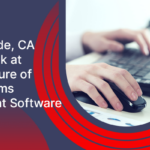Riverside, CA: A Look at the Future of Claims Management Software in 2024
July 25, 2024
Streamlining procedures and increasing productivity are two of the most important roles that technology innovations play in the constantly shifting environment of the healthcare industry. Cryptocurrency, also known as blockchain, is an example of a revolutionary technology that has gained importance in recent years. Blockchain’s decentralized and transparent nature provides a multitude of advantages that extend well beyond the realm of finance. Blockchain was first built to support cryptocurrencies to support them. Blockchain technology has emerged as a potent tool that may improve security and expedite operations in the context of claims processing software for health insurance.
Understanding the Challenges in Health Insurance Claims Processing Software
Health insurance claims processing software is an intricate and delicate undertaking that requires the participation of numerous parties, such as policyholders, insurance providers, and healthcare providers. Conventional approaches to claims management frequently encounter obstacles including data inaccuracies, fraudulent activities, and a dearth of transparency. Owing to antiquated legacy systems and labor-intensive manual verification procedures, operational delays, errors, and expenses are exacerbated. By directly confronting these challenges, the incorporation of blockchain technology into the claims processing system has the potential to bring about a significant paradigm shift in the industry.
Key Features of Blockchain in Health Insurance Claims Processing Software
Decentralization
Conventional claims processing software is vulnerable to security vulnerabilities and single points of failure due to its reliance on a centralized system. The decentralized network on which blockchain operates distributes data across a network of nodes. By preventing any one entity from exerting control over the entire system, the likelihood of unauthorized access or manipulation is significantly diminished.
Immutable Ledger
The ledger of a blockchain is immutable, signifying that any data contributed to it is permanent and cannot be modified or erased. This feature improves the reliability of health insurance claims data, by deterring fraudulent behaviors and assuring the accuracy and trustworthiness of the information.
Smart Contracts
Sensible contracts are contracts that are automatically executed based on the code that contains the conditions of the agreement. Smart contracts in health insurance claims processing software automate many phases of the claims lifecycle, therefore decreasing the need for human involvement and limiting the potential for mistakes.
Transparency
Transparency is a fundamental aspect of blockchain technology, enabling all authorized participants to have immediate access to the same dataset. This level of openness facilitates the reduction of conflicts, enhances communication among stakeholders, and cultivates confidence among all individuals involved in the claims process.
Enhanced Security
Blockchain utilizes cryptographic methods to safeguard data, rendering it exceptionally impervious to unlawful intrusion. Through the use of encryption techniques and the implementation of consensus procedures, blockchain effectively mitigates the likelihood of data breaches and assaults.
Interoperability
Blockchain enables easy integration with current systems and technology, fostering interoperability across diverse participants in the healthcare sector. Interoperability facilitates seamless communication and data exchange, resulting in enhanced efficiency and precision in claims processing.
Implementation of Blockchain in Health Insurance Claims Processing
The implementation of blockchain in health insurance claims processing involves collaboration among various stakeholders.
Here’s how the transition can be initiated:
Network Formation
Establish a consortium of healthcare providers, insurance companies, and other relevant entities to form a blockchain network. Define the rules and governance model for the network to ensure compliance with industry standards and regulations.
Data Standardization
Standardize data formats and coding systems to ensure uniformity across the blockchain network. This step is crucial for seamless data exchange and interoperability among different entities.
Smart Contract Development
Develop smart contracts to automate and streamline various stages of the claims processing lifecycle. Smart contracts can include predefined rules for claim approval, denial, and payment, reducing the need for manual intervention.
Integration with Existing Systems
Integrate blockchain technology with existing claims processing software to ensure a smooth transition. This step minimizes disruption to ongoing operations while leveraging the benefits of blockchain technology.
User Training and Adoption
Provide training to users and stakeholders on the new blockchain-based claims processing system. Encourage adoption by highlighting the efficiency gains, cost savings, and security enhancements offered by the new technology.
Benefits of Blockchain in Health Insurance Claims Processing
Fraud Prevention
The immutability of blockchain ensures that once a claim is recorded, it cannot be altered. This feature minimizes the risk of fraudulent claims, as any attempt to manipulate data would be easily detectable.
Cost Reduction
Automation through smart contracts reduces the need for manual verification and approval processes, leading to significant cost savings in terms of labor and operational expenses.
Faster Processing Times
Blockchain’s decentralized and automated nature accelerates the claims processing lifecycle, reducing the time it takes for claims to be submitted, verified, and settled.
Enhanced Accuracy
The transparency and immutability of blockchain contribute to the accuracy of claims data. This, in turn, reduces disputes and ensures that all stakeholders are working with consistent information.
Improved Patient Experience
Faster and more transparent claims processing results in a better overall experience for policyholders. Reduced processing times and increased trust contribute to higher customer satisfaction.
Regulatory Compliance
Blockchain can facilitate compliance with regulatory requirements by providing a transparent and auditable trail of all transactions. This feature is crucial in an industry where compliance is of utmost importance.
Challenges and Considerations
While blockchain holds immense promise for enhancing security in health insurance claims processing software, some challenges and considerations need to be addressed:
Regulatory Uncertainty
The regulatory landscape surrounding blockchain in healthcare is still evolving. Clear guidelines and standards need to be established to ensure compliance.
Scalability
Blockchain networks must be scalable to handle the volume of transactions involved in health insurance claims processing. Solutions such as off-chain scaling may be necessary.
Integration Complexity
Integrating blockchain with existing systems can be complex and may require significant resources. Proper planning and collaboration are essential to ensure a smooth transition.
Data Privacy
While blockchain provides transparency, ensuring the privacy of sensitive health data is crucial. Implementing robust encryption and access control mechanisms is essential.
Interoperability
Achieving interoperability among different blockchain networks and legacy systems is a challenge that requires industry-wide collaboration and standardization efforts.
Conclusion
The utilization of blockchain technology can fundamentally transform the procedure of health insurance claims by effectively tackling long-standing obstacles and bolstering security measures. The decentralized, transparent, and secure characteristics of blockchain have the potential to greatly reduce fraudulent activities, optimize processes, and enhance overall effectiveness within the healthcare ecosystem.
The use of blockchain technology in health insurance claims processing software is a significant advancement in the industry’s digital revolution, ensuring a more secure and robust future. The entire potential of blockchain in healthcare may be achieved via collaborative endeavors among stakeholders, well-defined legislative frameworks, and continuous technical improvements.
7 Features Every Online Claim Management System Needs
June 27, 2024What to Look for in Claims Management Software?
May 8, 2024









